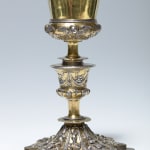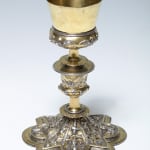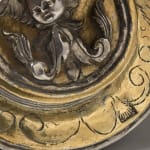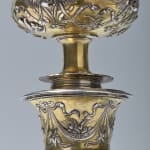CHALICE
Marks on the foot flange: Pilgrim venera inscribed within a square profile frame, and three-pointed vegetable crown.
Width: 19 cm
Weight: 938 g
Further images
-
(View a larger image of thumbnail 1
)

-
(View a larger image of thumbnail 2
)

-
(View a larger image of thumbnail 3
)

-
(View a larger image of thumbnail 4
)

-
(View a larger image of thumbnail 5
)

-
(View a larger image of thumbnail 6
)

-
(View a larger image of thumbnail 7
)

-
(View a larger image of thumbnail 8
)

-
(View a larger image of thumbnail 9
)

Provenance
Private collection, Europe.
Piece formed by a foot that sketches a star-shaped plant with a wide edge in which semicircular shapes alternate with pointed others, which lose their point as they reach the end of the edge. The base rises as a truncated cone and its narrowest spots are covered by candelieri decorations, while the widest areas are covered by cherubs with a vase that acts as a symmetrical axis in the composition. Over a flat washer with mouldings, there is a tall, plain and almost cylindrical drum, on top of which lies an apple with the shape of a vase with six blended oval mouldings on its base and a delicate decoration of hanging cloths and fruit on its neck. Then the same washer is repeated, but this last one has smaller dimensions and the piece becomes cylindrical and plain. The cup is slightly conical, while the sub-cup is bulbous (it fits its base) and shows four winged cherubs among hanging ribbons.
Embossed in the edge, there are two identical marks with the shape of a scallop with a flat valve, with its two ears next to its hinge, which reproduces the image of the pilgrim’s scallop shell (pecten jacobeus); therefore, the origin of the piece is easily recognizable. The icon is taken from the Santiago de Guatemala (Antigua) 1 heraldic. It is called in this way because of its allusion to the Pilgrim Apostle, the patron of this area, who gives his name to it and where this chalice was made. In the edge of the foot, in one of the blunt spots, there is a faulty engraving of a vegetable three-pointed crown, which means that the piece was examined by the fiscal control and complied with the “fifth” payment.
Both marks (of place of origin and fiscal tax) correspond to a morphology 2 which was used in the silversmiths’ workshops of Antigua from the middle of the sixteenth century until the end of the century, since they are mostly seen in the work of the marker Cosme Román (between 1553 and 1570, approximately). Since two marks out of the four required marks are missing (the marks of the author and the marker), it is very difficult to classify the chalice with precision, in relation to the period in which the work was done and the silversmith that made it. The only possible guide will be, therefore, a stylistic and typological analysis of the piece, in which certain peculiarities can be discovered since certain gothic characteristics in its structure were combined with decorations from the Renaissance. The choice of the star-shaped base with a wide edge corresponds to the characteristics of the last gothic, while the apple of the stem in the shape of a vase corresponds, as do the decorations, to the tastes of the central decade of the sixteenth century. The chronology of the chalice can be established in this period. The whole decorative repertoire reproduces some of the characteristic motifs of the first Renaissance, better known as “plateresque style”, in which floral vases, candelieri works, hanging cloths and cherub heads, worked with axial symmetry, cover the metal surface.
Nevertheless, if the mark of the chalice indicates that it was made in Guatemala and that it belongs to the middle of the sixteenth century, approximately, it is important to compare it with other pieces of this period to discover de dependency or originality of the piece and if its decorations are common among the silversmiths of Antigua. Up to this moment, we have not found another chalice such as this one, but we did find a similar stem shape and a vase with a bulbous 3 base in two pieces: one of them belongs to the Várez Fisa 4 Collection and the other is kept at the Tuxtla Gutiérrez Cathedral (Chiapas, Mexico). 5 Regarding the diagram of the foot, it coincides with this last piece and with a reliquary which was exhibited in the Maastricht Fair in 2009. Regarding the decorations, the most repeated motif is the head of an angel with spread wings, which invariably appears in the lower part of the cup; however, they are also frequent in the base.
Not many engraved chalices from the sixteenth century made in Antigua city (Santiago de Guatemala) are known at the moment; therefore, the reference to this one, which is now coming into light, is of utmost importance to reconstruct the religious silverwork produced in the workshops of this important Central American artistic centre. Moreover, considering its simple type, perfect harmony is found in the structure of this chalice due to the order and separation of the parts that compose it. Most importantly, it is an outstanding piece due to its elegant decorative vocabulary which was worked with a great plastic sense, in which motifs were drawn with certainty and a strong volume which makes them stand out, powerfully, against a plain background. All in all, it is a very singular piece because of its artistic quality and, most of all, its old age.








